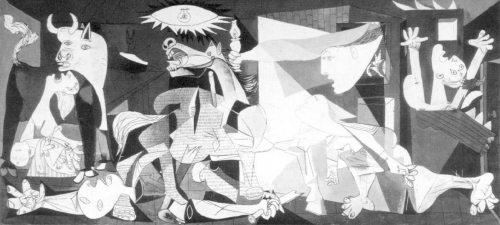Guernica

Jenny Farrell takes us through one of the greatest political artworks ever, Picasso's Guernica.
There are a handful of pictures that may be said to be almost universally known. They include Leonardo’s Mona Lisa, Edvard Munch’s The Scream and Picasso’s Guernica.
Eighty years ago, on 26 April 1937 the small Basque town of Guernica was annihilated by German bombers. Picasso heard of this act of terror on 28 April and began initial sketches in response to this atrocity on 1 May. It became the painting Guernica.
Despite its familiarity, or perhaps because of it, it is interesting to take a closer look at this iconic painting and discover more about what is says, exactly, and why it has the effect it has on the viewer.
The title is as terror-filled as the images displayed. In February 1936, the popular front had won the democratic elections in Spain. In July, a putsch by fascist generals took place under the leadership of Franco, supported by Hitler, Mussolini and international capital. A three year long civil war was unleashed, which ended in the crushing defeat of Spanish democracy.
Picasso had been commissioned in January 1937 to produce a mural sized painting for the Spanish Pavilion at the Paris International Exposition of Art and Technology in Modern Life. At a time, when the second world war had already begun in Spain, the German and Soviet pavilions stood across from each other on the exhibition grounds – the German eagle facing hammer and sickle. The Spanish pavilion aimed to highlight the just cause of the Spanish Republic and call for international support. It, too, represented the forces of humanity and culture against fascism barbarism. Picasso’s Guernica was exhibited in the open lobby.
Picasso began work on this painting in May 1937 and installed it in Paris in mid-June.
To understand the painting requires a degree of effort to decipher the abstract images. In its formal composition, Picasso combines the Christian triptych (traditionally an altar piece depicting Christ’ suffering on the cross on a large central panel, flanked by two narrower wings) with the classical Greek triangular pediment (a sculptured gable). In this way, Picasso’s combination distils highpoints of European culture and uses them against barbarism.
The painting shows two animals and five people. All of these have symbolic functions. The bull and the horse – are traditional symbols of Spanish popular culture, classical mythology, indeed any farming or nomadic cultures breeding horses and bulls. The clearest symbolic figures aside from these are the torch-bearer and the pieta.
In the painting, there are two sources of light: the torch and the electric bulb/ sun, positioned centre top of the picture. The woman carrying the flame, associates the entire tradition of enlightenment humanism to this day, albeit here illuminating the perversion of humanism – the destruction of life. The light-bearing woman is closely linked to liberty in the visual arts as well as in literature. One example is the New York statue of liberty, based on the Roman goddess Libertas, another famous case in point is Delacroix’s famous painting of the Liberty Leading the French Revolution.
Turning to the electric bulb/ sun, the cult of light is associated with Apollo in Greek mythology and in Christian culture, light traditionally represents God.
These two sources of light more or less at the top centre of the painting shed a triangle of light on what lies beneath – a scene of horrendous human pain and destruction. If you imagine lines drawn down from the flame to shape a triangle with the base of the painting, you have the pediment of the classical temple, coinciding with the central panel of the triptych.
What does the light illuminate? From right to left – this is the movement of the picture – a half-clothed woman is fleeing from a burning town. A human is trapped in the flames, screaming, about to be consumed. At the centre is the horse, fatally stabbed by a dagger in its back, writhing in mortal anguish. Underfoot are dismembered human body parts: an arm grasping a broken sword beside the faint outline of a flower. Another arm is stretched out in agony beside a severed head, engraved with horror. The outstretched hand reaches into the left corner of the painting and shows the effort made to protect the dead baby held by its grief stricken mother. Thinking of the painting as a triptych, the wailing mother and the burning person are in the wings, to either side of the centre panel. Both these characters and the horse are shown screaming, protesting and resisting in the moment of their destruction.
The powerful head of a female torch bearer, representing reason, civilisation and a democratic world public, sweeps through the picture from the right. She is witness, both seeing and revealing the horrors of Guernica. She embodies life, energy and hope.
Hovering over the mother in the left wing is the bull, a deep source of hope and resistance. The animal is not wounded, although its eyes and mouth express sadness and anger. It represents the power of indestructible, life-giving nature. Since ancient times, the bull has connotations of fertility. It represents the innate power of the people.
The horse, its stricken head, is at the centre of the triangular pediment and the triptych structure, just below the light. The horse has special significance in this painting. It distils the suffering of the people and becomes the essence of this. The horse’s head heightens the agony, the elegiac tone of the entire picture, becomes its symbol.
The horse, in its anguish, is positioned in between the torch bearer and the bull, reason and nature, which, combined, guarantee the regeneration of life. The frail but visible flower beside the fallen soldier also symbolises rebirth. The combined power of reason and nature engender optimism for new life, resistance and struggle to overcome such destruction. The movement of the head of reason is towards the bull. As the head is without a body, such merging is almost certainly part of the painting’s projected intention. Another factor that suggests the necessary joining of torch bearer and bull, of head and heart, of reason and body, is that these two figures alone in the painting, are not physically tormented in the same way as the humans are. The bull is distressed and the torch bearer horrified; together they embody ground for hope, for anger, the will to resist and fight back, for renewal.
Looking at the ‘language’ of the painting, its form, the questions arises: How can such horror be depicted appropriately? Is it possible to express profound and utter destruction in a naturalistic, ‘beautiful’ way? This painting is in black and white, creating a level of abstraction for the viewer on the one hand, adding the suggestions of a torn newspaper photograph on the other. The effect is distancing. The viewer is not drawn in, doesn’t totally identify with the images, but is put into a position of observer, thinking about what is presented.
The size of the painting also acts to physically distance the onlooker: it is 3.49 metres (11 ft 5 in) tall and 7.76 metres (25 ft 6 in) wide and cannot be seen properly close-up. The observer needs to stand at a distance to take in the whole, and make effort to understand. Grasping the message of the work parallels the effort to understand history. It isn’t presented beautifully on a plate, but needs grappling.
As indicated, the characters displayed are representative. They depict the collective experience of the Spanish people and beyond that, of the human race in a world at war. This is THE mother mourning her child, THE person fleeing from a burning city, THE human consumed by its flames, THE fallen soldier, THE world in flames. The composition furthermore suggests both indoors and outdoors, thereby making it a more universal space. Thus, the painting becomes a comprehensive statement against the inhumanity of war. It is both a condemnation and an appeal to fight for peace.
And so, as we commemorate the fascist attack on a small Basque town, as we remember and mourn its dead, our awareness of the ongoing wars, continuing crimes against humanity, human suffering and horror, perpetuated by the very same imperialist greed and inhumanity, is heightened when looking at Picasso’s masterpiece.

Based on an essay by Thomas Metscher, published in: Thomas Metscher, Der Friedensgedanke in der Europäischen Literatur (1984)

Jenny Farrell
Jenny Farrell is a lecturer, writer and an Associate Editor of Culture Matters.